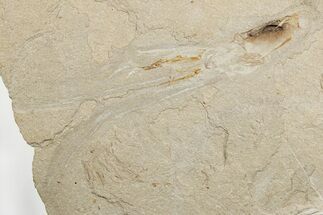This Specimen has been sold.
Soft-Bodied Naraoiid Arthropod (Naraoia)
This is another exceptional offering from a high end collection of material primarily acquired in the 1980's and 1990's which is being sold through FossilEra.com The specimens from this collection represent some of the highest quality examples of their types found.
Please Note: The Chengjiang fossil beds are now a protected UNESCO World Heritage site and several different laws put in place over the past two decades effectively ban the export of nearly all fossils from China. This specimen was legally acquired by the collector in 1995-1996 prior to any export restrictions or restrictions on the Chengjiang fossil beds.
The Chengjiang region of China is noted for soft-tissue fossil finds, in the Maotianshan Shale - considered “as spectacular as the Burgess Shale fauna and significantly older" As such, these fossils are considered one of the most important fossil finds of the 20th Century.
Naraoia is a genus of small (about 7 - 35mm long) marine arthropods within the family Naraoiidae, that lived from the early Cambrian to the late Silurian period. The species are characterized by a large alimentary system and sideways oriented antennas.
Sediments present in the gut of Naraoia suggest that it may have been a deposit feeder, eating large amounts of soil, like an earthworm; A very large, complex system of gut diverticula and a gut with great holding capacity indicate that the diet of Naraoia spinosa was low in nutrition. The taxonomic placement of the soft bodied Naraoiidae has been controversial, even though detailed appendages have been seen in some fossils that reveal biramous appendages which are very similar to true trilobites.
Naraoia is almost flat (dorso-ventrally). The upper (or dorsal) side of the body consists of a non-calcified transversely oval or semi-circular headshield (cephalon), and a tailshield (pygidium) longer than the cephalon, without any body segments in between. The body is narrowed at the articulation between cephalon and pygidium. There are no eyes. The gut has a relatively large diameter (14-18% of the width of the body), and there are four pairs of large digestive sacs (or caeca) The cephalon has branched diverticula occupying most of the cephalon - a feature clearly defined on this specimen.
It is important to note that local phosphate mining brings in some 2/3 of the county's revenue, so there’s a dilemma between calls for preservation these amazing fossils and finding a balance between exploitation and restoration of the land. Efforts have been made to close the region to mining in a bid to support Chengjiang County’s listing as a World Heritage Site, given the scientific significance of the fossils.
Please Note: The Chengjiang fossil beds are now a protected UNESCO World Heritage site and several different laws put in place over the past two decades effectively ban the export of nearly all fossils from China. This specimen was legally acquired by the collector in 1995-1996 prior to any export restrictions or restrictions on the Chengjiang fossil beds.
The Chengjiang region of China is noted for soft-tissue fossil finds, in the Maotianshan Shale - considered “as spectacular as the Burgess Shale fauna and significantly older" As such, these fossils are considered one of the most important fossil finds of the 20th Century.
Naraoia is a genus of small (about 7 - 35mm long) marine arthropods within the family Naraoiidae, that lived from the early Cambrian to the late Silurian period. The species are characterized by a large alimentary system and sideways oriented antennas.
Sediments present in the gut of Naraoia suggest that it may have been a deposit feeder, eating large amounts of soil, like an earthworm; A very large, complex system of gut diverticula and a gut with great holding capacity indicate that the diet of Naraoia spinosa was low in nutrition. The taxonomic placement of the soft bodied Naraoiidae has been controversial, even though detailed appendages have been seen in some fossils that reveal biramous appendages which are very similar to true trilobites.
Naraoia is almost flat (dorso-ventrally). The upper (or dorsal) side of the body consists of a non-calcified transversely oval or semi-circular headshield (cephalon), and a tailshield (pygidium) longer than the cephalon, without any body segments in between. The body is narrowed at the articulation between cephalon and pygidium. There are no eyes. The gut has a relatively large diameter (14-18% of the width of the body), and there are four pairs of large digestive sacs (or caeca) The cephalon has branched diverticula occupying most of the cephalon - a feature clearly defined on this specimen.
It is important to note that local phosphate mining brings in some 2/3 of the county's revenue, so there’s a dilemma between calls for preservation these amazing fossils and finding a balance between exploitation and restoration of the land. Efforts have been made to close the region to mining in a bid to support Chengjiang County’s listing as a World Heritage Site, given the scientific significance of the fossils.
SPECIES
Naraoia spinosa
LOCATION
Maotia’shan shale - Chengjiang, Yunnan, China
FORMATION
Yu'anshan Member of the Heilinpu Formation
SIZE
.55" long on 3.1" matrix
CATEGORY
ITEM
#14932
We guarantee the authenticity of all of our specimens.
 Reviews
Reviews












